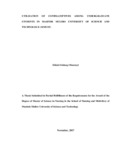UTILIZATION OF CONTRACEPTIVES AMONG UNDERGRADUATE STUDENTS IN MASINDE MULIRO UNIVERSITY OF SCIENCE AND TECHNOLOGY (MMUST)
Abstract
Contraceptives uptake among the youth has been a sensitive and controversial issue in the
society that has resulted to various social problems that include unwanted pregnancies
and sexual transmitted infections among others. This calls for intervention measures that
will promote contraceptive use in order to reduce unwanted pregnancies, sexual
transmitted diseases and slow down the spread of HIV/AIDS among university students.
The main objective of this study was to determine the utilization of contraceptives among
undergraduate students in MMUST. Specifically, the study sought to determine the extent
of contraceptive utilization, establish the influence of social relation on contraceptive
utilization and examine the effect of addictive behavior on uptake of contraceptives.
Quantitative research method which is contextual in nature was used for the study.
Stratified random sampling was used to identify 453 undergraduate students from
MMUST who participated in the study. Quantitative data was analyzed using both
descriptive and inferential statistics. Descriptive statistics including frequencies and
percentages were used to organize data and information for further analysis. Logistic
regression analysis was performed to determine the association between the variables.
The study revealed that contraceptive prevalence rate among the undergraduate students
was 62.7% and majority (25.4%) of the users sought the services from government health
facilities. The study also demonstrated that knowledge of contraceptive methods among
the undergraduate students was 90% and condoms were the most preferred method
(75.6%) followed by pills (15.1%). Electronic media was found to be the most popular
(40.1%) source of contraceptive information. Age of respondents and the age at which
the respondents left high school was found to have a significant influence on
contraceptive utilization (OR=1.43: 95%CI=1.02-2.14, p<0.05 and OR=1.88:
95%CI=1.21-2.92, p<0.05 respectively). Also, there was significant association between
male respondents who discussed sexuality with their fathers and peers (OR=1.56:
95%CI=1.05-2.35, p<0.05 and OR=0.47: 95%CI=0.29-0.78, p<0.05 respectively).
Female respondents who discussed sexuality with their mothers, peers and partner were
found to be significantly associated with contraceptive use (OR=0.54: 95%CI=0.31-0.95,
p<0.05; OR=2.47: 95%CI=1.01-6.05, p<0.05 and OR=1.79: 95%CI=1.96-3.24, p<0.05
respectively).Alcohol consumption and clubbing were equally found to have a significant
influence on contraceptive uptake (OR=0.33: 95%CI; 0.18-0.59, p<0.05 and OR=0.48
95%CI; 0.27-0.84, p<0.05 respectively). It was thus concluded that although
contraceptive prevalence among the university student was relatively high there is need to
increase the usage. The involvement of parents, peers, partners and the university
community was critical in regard to contraceptive utilization. Expansion of the
distribution channels and use of adequate information and networks that provide a
fundamental link between contraceptive awareness can improve utilization. This study
recommends inclusion of contraceptive component in the university curriculum as an
intervention to increase the uptake of contraceptive uptake among the youth. Also,
involvement of parents, peers, partners and the university should be enhanced in order to
support the government effort in its attempt to address unwanted
pregnancies and the spread of HIV/AIDs among the youth..

